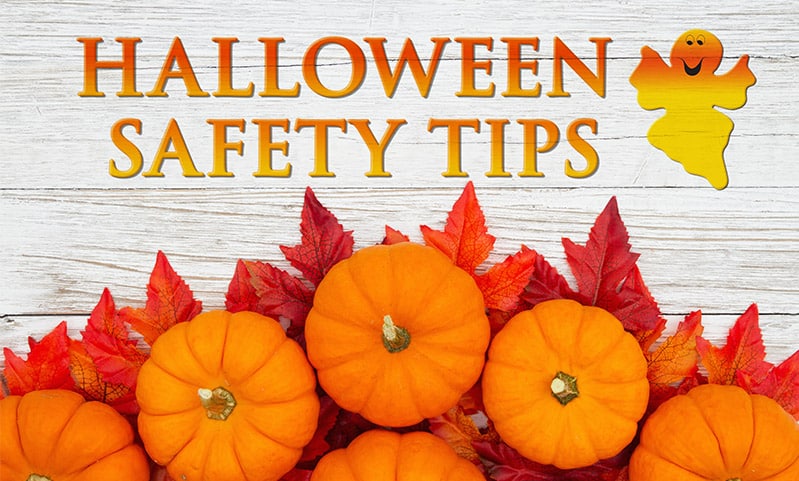Excitement fills the autumn air for everyone around this time of year. Halloween begins the holiday season, and whether you’re giving candy or getting candy this year, we all play a part in ensuring that this Halloween is safe and fun.
The average number of fatalities annually on October 31st is nearly double the average number for other days, and most fatalities occur during the trick-or-treating twilight hours.
For children especially, Halloween is a risk-filled night of the year. Spooky, right? And it’s not ghosts, ghouls, and goblins killing kids- it’s cars.
The most common injuries for kids on Halloween night are pedestrian accidents. Because more kids are wandering around from dusk to dark, more get hit by cars than on any other night of the year.
Children aged four through eight are most at risk. Here are a few precautions parents can take:
- Make sure your kids are staying on the sidewalk and checking carefully before crossing at intersections and crosswalks
- Give them flashlights or reflective gear to wear on their costumes
- Accompany them at all times or, if they are old enough, send them trick or treating in a group
- If your child is wearing a mask or costume that limits their vision, tell them to take it off while crossing the street
Young drivers aged 15 to 25 were the most likely to cause these Halloween nightmares. If you’re driving this Halloween, drive extra slowly through neighborhoods.
If you are drinking, do not drink and drive. Never drink and drive. Call an Uber, Lyft, or cab, or have a designated driver. Calling a car service is a better option than using a scooter or bike to get home, as those pose a risk as well.
Once your little vampires, fairies, and superheroes have made it home safely, there are still more safety measures parents can take.
Check your children’s candy and throw out any pieces that are in an unrecognizable wrapper or have been opened. For anything that looks sketchy, just throw it out.
Although it is very rare, we’ve all heard the horror stories of razor blade Reese’s, drugged up Dum Dums, and poisonous Pixy Stix.
Most of these instances have actually not been a case of a sociopath randomly targeting trick-or-treaters, but the culprit knew the victim- usually a family member or a “friend.”
Last Thursday, Pennsylvania’s Johnstown Police Department confiscated Nerds Rope edibles that contained 400mg of THC (the psychoactive chemical in marijuana).
“During this Halloween, we urge parents to be ever vigilant in checking their children’s candy before allowing them to consume those treats,” the Johnstown Police Department posted on Facebook.
“Drug laced edibles are packaged like regular candy and may be hard to distinguish from the real candy.”
But even non-tampered with candies can pose a threat to excited children. If your kid has allergies, the following is a list of some top 8+ allergen free candy brands:
- Dots
- Skittles
- Smarties
- Sour Patch Kids
- Starbursts
- Swedish Fish
- Ring Pop
- Free2b Sun Cups
- No Whey Spider Pops
For more, click here. Still read the labels carefully!
Here is a list of some gluten-free candies for those with a gluten allergy
- Hershey kisses
- Almond Joy
- Heath bars
- Milk Duds
- Reese’s Peanut Butter Cups
- Reese’s Pieces
- York Peppermint Patties
- Rolo Caramels in milk chocolate
- Jelly Belly
- Butterfinger (original flavor)
- Laffy Taffy
- Baby Ruth
- Nips
- Raisinets
- Smarties
- Welch’s Fruit Snacks
- Sour Patch Kids
Check out this list for even more options. Still double-check the labels!
Even if your child doesn’t have allergies or dietary restrictions, you can still be sensitive to trick-or-treaters who do have these food limitations or other medical conditions that restrict candy consumption.
Teal pumpkins signal non-food items for children with allergies. If you’re leaving your house to accompany your kids on Halloween night, put a little note explaining that those items are for kids who have food restrictions and not for those who don’t!
Here are some non-food items you can give out instead of or in addition to candy:
- Spider rings
- Wristbands
- Bouncy balls
- Bubbles
- Books (not religious)
- Your mixtape
- Glowsticks
- Play-Doh
- Extra Large Pencils (always funny)
- Slappy hands
- Pokémon cards
- Tiny Slinkys
- Plastic Vampire fangs
- Stickers
This allows kids apart of the eight percent of the U.S. population who have food allergies and kids with diabetes to enjoy Halloween the same as everyone else.
Lastly, make your home safe for trick-or-treaters by cleaning up your yard. All Halloween decorations should be in the lawn to prevent children from tripping over them.
Use festive lights around the driveway or walkway to guide kids to your door. Keep your pets inside- pets can spook kids and not in the fun way.
Scaring kids on Halloween is a lot of fun, but don’t scare them in a way that might cause injury. This Halloween, we will all beware!
